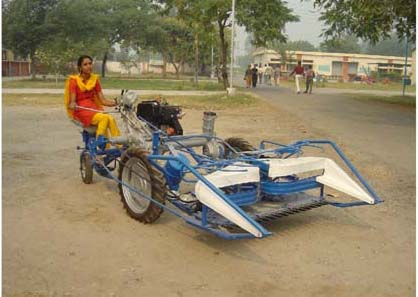
The present report begins with a review of the status and performance of agriculture, especially during the last two decades, and also presents what could be the way forward, given our objectives of accelerated growth, inclusiveness and the reducing of poverty and hunger. As per the report, the significance of agriculture sector in India is not restricted to its contribution to GDP, but that on account of its complementarity with other sectors. It has far reaching ability to impact poverty alleviation and rural development. There are several areas of importance for the agriculture sector growth. These include, among others, enhancing public sector investment in research apart from effective transfer of technology along with institutional reforms in the research set up to make it more accountable and geared towards delivery, conservation of land, water and biological resources, the development of rainfed agriculture, the development of minor irrigation, timely and adequate availability of inputs, support for marketing infrastructure, an increase in flow of credit particularly to the small and marginal farmers.
The report highlights the fall in contribution of agriculture to the overall Gross Domestic Product (GDP), which has gone down to 13.9 per cent. It notes that this trend is expected in the development process of any economy. Yet, agriculture forms the backbone of development, as 52 per cent of India’s work force is still engaged in agriculture for its livelihood and is important for food security and inclusive growth.
The report highlights the records achieved in the production of foodgrains and many other crops. Among the major steps taken in the recent years for improving crop production and productivity, the report specially highlights the contribution made by the Rashtriya Krishi Vikas Yojana (RKVY) towards increasing public investment in agriculture and allied sectors. National Food Security Mission (NFSM) and the National Horticulture Mission (NHM) have also emerged as the path breaking interventions which have helped in achieving record production of cereals, pulses, oilseeds, fruits, vegetables and spices during the last two years. Bringing Green Revolution in Eastern India (BGREI) has been started to increase the productivity of the cropping system mainly rice, wheat, maize, pulses through promotion of innovative production technologies and agronomical practices addressing the underlying key constraints of different agro-climatic sub regions.
in the recent years for improving crop production and productivity, the report specially highlights the contribution made by the Rashtriya Krishi Vikas Yojana (RKVY) towards increasing public investment in agriculture and allied sectors. National Food Security Mission (NFSM) and the National Horticulture Mission (NHM) have also emerged as the path breaking interventions which have helped in achieving record production of cereals, pulses, oilseeds, fruits, vegetables and spices during the last two years. Bringing Green Revolution in Eastern India (BGREI) has been started to increase the productivity of the cropping system mainly rice, wheat, maize, pulses through promotion of innovative production technologies and agronomical practices addressing the underlying key constraints of different agro-climatic sub regions.
The report emphasises the need to bridge the yield gap in low productivity regions by technology, inputs and other interventions. Raising productivity also assumes significance in view of increasing demand for land for industrialization, urbanization, housing and infrastructure.
The report takes note of the structural changes in the composition of Indian agriculture, leading to diversification into horticulture, livestock and fisheries since the 1990s. Analysing the likely high contribution of these high-value sectors, the report says that the shares of fruits & vegetables and livestock have shown an increasing trend in recent years and have been growing at much faster rates than the traditional crops sector. Given the rising share of high value commodities in the total value of agricultural output and their growth potential, this segment is expected to drive agricultural growth in the years to come. Bringing in reforms to streamline domestic markets and expanding the infrastructure and institutions to connect local markets with national and global markets, will go a long way in improving India’s competitiveness and the benefits from trade liberalization. Higher investment in basic infrastructure like roads, canal waters, watersheds, check dams, etc. will attract private investment in other areas of the supply chain.
Highlighting the importance of private sector investment, the report observes that the private sector responds much better and faster to the incentive structures. Hence, along with bringing in greater public investment in agriculture, there is a need for bringing in reforms in the incentive structure in agriculture.

Discussing the consequences of rising population pressure on farming and its capacity to provide employment, the report calls for creation of additional employment opportunities in the non-farm and manufacturing sectors, especially in agro based rural industries which have area specific comparative advantage in terms of resources endowment and development possibilities. This would require suitable skill development of the people so as to gainfully employ them in non- farm activities. This would make agriculture viable in a sustainable manner.
On the impact of the Mahatma Gandhi National Rural Employment Guarantee Scheme (MGNREGS) on agriculture and farm labour, the report refers to the evaluation studies carried out recently which have shown that while MGNREGS has contributed toward water conservation and water harvesting structures, drought proofing and tree plantation, flood control, micro and minor irrigation works and land development which will have a positive impact on agricultural productivity, it has also led to a substantial increases in the wage rates of agricultural labourers, reduced the availability of labor for agricultural operations and increased the cost of cultivation. In order to optimize synergies and bring convergence between MGNREGA and schemes of Ministry of Agriculture, guidance has been issued to state governments.
While increased productivity is an essential component of a vibrant agricultural sector, improved post-harvest handling and processing is essential to ensure high-quality products reach the markets. Too often, even when the yields are high, producers lose income due to poor post-harvest practices.
The report cautions that water scarcity will intensify in future with increase in population and demand for food, and the current water use practices cannot be sustained over the long run. Inefficient water use in irrigation is also leading to environmental degradation via water logging and induced salinity. Irrigation efficiency in the systems needs to be improved. The report estimates that even a rise of 5 per cent irrigation efficiency can increase the irrigation potential by 10-15 million ha.
The report also focuses on the problems of imbalanced use of fertilizers, deteriorating soil health and the threats posed by climate change and highlights the recent measures initiated to tackle these issues.
As per the report, the National Policy for Farmers emphasizes the use of Information and Communication Technology (ICT) at village level for reaching out to the farmers with the correct advisories and requisite information. ICT Tools and Space Science Applications are also being used for ensuring greater reliability of crop yield and production estimates which will help in improving the process of planning and policy making. In this connection, sustained efforts have been made to improve and harness the latest Information Technology techniques to capture and collate data, add value to it and disseminate the same to all the stakeholders.
On farm credit, the report calls for innovative ways to reach people still out of the umbrella of institutional credit. The report says that while the overall credit to agriculture has been growing phenomenally during the last few years, and the interest rates for farmers have also been reduced to 7 percent (4 percent after taking into account the 3 percent interest subvention for timely repayment of crop loans), yet the biggest challenge remains in terms of increasing access to credit, particularly for the bottom 40 percent. More innovative models are needed to reach this category as they rely largely on the informal sector for credit with high rates of interest.
The report calls for wide-ranging reforms in agricultural marketing. Imperfect market conditions and restrictions on the movement of agricultural commodities are not letting the farmers to realize the true value of their produce, whereas it is causing the consumer to pay a much higher price than warranted. The linking of small and fragmented farms with large-scale processors and retailers remains a challenge in the high value sector. With this in view Government has decided that assistance under National Horticulture Mission and Development and Strengthening of Agricultural Marketing Infrastructure, Grading and Standardization Scheme for development of market infrastructure projects to State Agencies/APMCs would be subjected to waiving of market fees for perishable horticultural commodities. With a view to overcome this shortcoming and to bring in private sector investment and techno-managerial efficiencies, government is promoting Public Private Partnerships (PPP) in infrastructure development through ‘viability gap funding’ support, the report says.
To download the report, click here